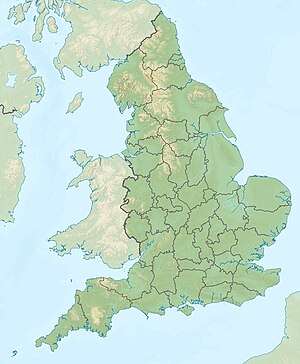Diggle Moss
| Diggle Moss Reservoir Black Moss Reservoir |
|||||||
|---|---|---|---|---|---|---|---|
| Looking south over the reservoir from the Pennine Way | |||||||
|
|||||||
|
|
|||||||
| Coordinates | 53 ° 34 '32 " N , 1 ° 57' 3" W | ||||||
| Data on the structure | |||||||
| Data on the reservoir | |||||||
| Reservoir length | 270 m | ||||||
| Reservoir width | 330 m | ||||||
| The reservoir in a drained state | |||||||
The Diggle Moss Reservoir (also called Black Moss) is a small reservoir east of Manchester in the catchment area of the River Colne in West Yorkshire, England. Like several others, the reservoir served as a water supply for the Huddersfield Narrow Canal .
The dam breach
During the construction of the Huddersfield Narrow Canal by the Huddersfield Canal Company under the direction of Benjamin Outram broke on November 29, 1810 after prolonged rainfall, the dam of the Diggle Moss reservoir and created the "Black Flood", which the place Marsden in The valley of the Colne flooded. Houses and factory buildings were destroyed and six people died. The dead were Esther Schofield, their daughter Mary, eight months old, their brothers Joseph Haigh, 14 years old, and James, 12 years old, and their niece Betty Schofield, three years old, daughter of their sister Hannah and Joseph Schofield from Puleside. The sixth dead was the wife of a miller named Bamforth. Other sources only name five dead.
The power of the water was so great that a stone weighing 15 tons was carried 3.2 km down the valley. The material damage was put at 450 pounds.
Marsden had already been flooded once in 1799. The further reservoir below in the direction of Wessenden, the Swillers Reservoir, also known as Swellands Reservoir, was built in 1825 and did not exist when the dam broke.
causes
The reservoir has two barrier structures, a western main dam on the Diggle side and an eastern secondary dam towards Wessenden. It was the side dam that broke. It was later discovered that it was not properly built and founded. There was peat in the dam construction material and moss and heather were found in the foundation. It is not known whether the dam was flooded or started sliding. The designation "Black Moss" indicates bog, moss, peat and black colored water, hence "Black Flood".
Individual evidence
- ↑ a b Tale of a tragedy, Huddersfield Examiner
- ↑ a b Lessons from historical dam incidents PDF document 2962 kB
- ^ Tunnel End, Marsden, Huddersfield
literature
- Binnie GM, 1976: The evolution of British dams. Twelfth Dickinson Memorial Lecture. Transactions of Newcomen Society, 47, 207-224.
- Smith RA, 1985: Discussion on the failure of embankment dams. Proceedings of Symposium on Failures in Earthworks, 228-232. Thomas Telford, London.


